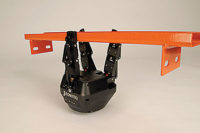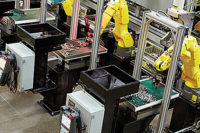At Ford engine plants, multifastener joints such as cam covers, front covers and intake manifolds have traditionally been assembled using hard-tooled, multispindle power heads at dedicated run-down stations. The heads are mounted on pneumatic, hydraulic or electromechanical slides. The spindles (one per fastener) are fixed in place, and they simultaneously tighten all the fasteners to a specific torque.
On applications such as the cam cover for Ford’s V-8 engine, this can require as many as 27 spindles at a cost of approximately $15,000 per spindle. The spindles are arranged to match the fastener pattern of the component being assembled. Because each run-down station is dedicated to a specific engine, additional stations are required on the assembly line to accommodate different engines. The total cost of a hard-tooled, multispindle fastening station ranges from $525,000 to $700,000, depending on the engine application and number of fasteners involved.
The hard-tooled, multispindle fastening approach was (and still is) an effective and economical solution on engine assembly lines characterized by high volumes, low complexity and short cycle Arial. However, for its new V and I engine programs, Ford took a different strategic direction. We wanted to design a low- to medium-volume engine assembly line that was very flexible, that could support a high degree of product complexity, and that was easily convertible.
In developing flexible torquing technology, we wanted to meet the following objectives:
- Be able to tighten multifastener hard joints that are typically found on engine applications.
- Demonstrate the feasibility of single-spindle torquing to provide consistent, high-quality joints in a production environment.
- Reduce the life cycle cost of production equipment for new programs.
The project team also consisted of members from the following Ford organizations: Powertrain Operations Manufacturing Engineering, Powertrain Operations V-Engine Design and the low-volume assembly line at the Windsor Engine Plant in Windsor, ON, Canada. In addition, the following suppliers were directly involved in the effort: Comau Pico (Southfield, MI), ABB (New Berlin, WI) and Advanced Fastening Systems (AFS, Sterling Heights, MI).
Technology Development
Because the main objective of the project was to develop flexible torquing technology, this led naturally to incorporating existing robot technology as the basis of the solution.Our flexible torquing technology integrates two major components. A standard six-axis robot replaces the wing base, column and power head of a traditional hard-tooled, multispindle fastening station. The robot manufacturer’s controller governs the robot’s motions. A single DC-electric fastening spindle is mounted onto the end tooling of the robot arm. The spindle is controlled by the tool manufacturer’s PC-based controller. A separate programmable logic controller (PLC) synchronizes events between the robot and the spindle.
The robot tightens the fasteners one at a time in a predetermined sequence. The robot sequentially positions the spindle over each fastener. The spindle controller then initiates and monitors the tightening sequence for that fastener. Critical torque data and pass-fail information is recorded and stored for each fastener.
Our flexible torquing technology underwent extensive testing and trials on a representative test cell to confirm joint integrity and establish cycle Arial with the "stitching," or alternate, fastening sequence. Simultaneous engineering activities and feasibility studies on engine applications were completed in 1997, and the flexible torquing technology was deemed ready for production.
Production Implementation
Our flexible torquing technology was implemented for the first time Jan. 5, 1998, on the low-volume line at the Windsor Engine Plant. The technology was used to assemble the 1999 4.6-liter, two-valve engine and the 5.4-liter, two-valve and four-valve engines.The engine assembly line at Windsor has a cycle time of 49 seconds. It can build more than 30 different engine codes and has an annual volume capacity of 200,000 engines.
The fastening robot was used on the following applications:
- Front cover run-down stations (two stations with one robot per station).
- Spark plug installation and run-down station (one station with two robots).
- Cam cover run-down stations (two stations with two robots per station).
One way that Ford measures the effectiveness of new technologies is to see if they can be successfully implemented at other plants. Based on the successful pilot applications at Windsor, the robotic torquing technology was replicated on the low-volume assembly line at the Ford Engine Plant in Romeo, MI, during the third quarter of 2000. The technology was used to assemble the 2001 4.6-liter, two-valve engine and the 5.4-liter, two-valve and four-valve engines.
The engine assembly line at the Romeo plant has a cycle time of 42 seconds. It can build more than 30 different engine codes and has an annual volume capacity of 235,000 engines.
The fastening robots were used in applications that were similar to the ones at Windsor. In addition, the robotic technology was adapted and migrated to in-process test equipment for the engines. Specifically, the technology was used at a compression check station, which consisted of two robots.
With the highly successful implementations at Windsor and Romeo, the technology was established as a best practice within Ford. In addition, the technology is now documented in the Ford Manufacturing Common Planning and Engineering Methods specifications as the recommended torquing strategy on low-volume engine lines, or lines with typical cycle Arial of 40 to 55 seconds.
Typical Run-Down Station
At the Windsor plant, both the 4.6-liter, two-valve engine and the 5.4-liter, two-valve engine have 13 fasteners on the right-hand cam cover and 14 fasteners on the left-hand cam cover. Although both engines use the same cam covers and have the same total number of fasteners on the cam covers, the fastener locations in the X, Y and Z planes are unique due to a difference in deck heights. The 5.4-liter, four-valve engine has unique cam covers with 10 fasteners on the right-hand cam cover and 10 fasteners on the left-hand cam cover. Also, the fastener locations in the X, Y and Z planes are unique, due to the four-valve cylinder head configuration. The fasteners used on all three engines are a combination of M6 bolts and M6 studs, tightened to a torque of 8 to 12 newton-meters.If those three engines were assembled with the traditional run-down process, at least two, and possibly three, hard-tooled multispindle stations would have been required. In addition, a minimum of 47 fixed spindles would have been required on the power heads.
Instead, we installed two identical robotic stations to attach the cam covers. Each station employs two ABB 4400 series robots. One AFS DC-electric spindle is mounted onto the end tooling of each robot.
The engines are carried on dedicated pallets and transferred into the station by hard automation. A pallet stop and a lift-and-locate unit in the station position the engine for assembly. A radio-frequency (RF) tag mounted to the engine pallet has the engine build "recipe" encoded into it. An antenna at the station reads the RF tag information, and the PLC selects the appropriate run-down program for that particular engine code. The robot then positions the spindle over each fastener to engage the socket onto the M6 bolt or stud hex. The torquing sequence is initiated, and the fasteners are run down sequentially in a stitch pattern, one at a time.
If one of the flexible torquing stations breaks down, it can be fully backed-up by the other station until repairs can be made during the off shift. This keeps the production line moving.
Benefits of Robotic Torquing
Our flexible torquing technology has provided numerous benefits.First, it allows us to manage greater product complexity. The robots accommodate both V and I engine configurations, 60- and 90-degree bank angles, and two-, three- and four-valve cylinder head arrangements.
Second, the robots give us great process flexibility. They can drive multiple fasteners in varying bolt patterns. They handle different fastener types and hex sizes. And, we can tailor torquing sequences and torque parameters to each product.
Third, the robots have improved line efficiency. They have dramatically reduced changeovers. They have decreased cross-threading and part handling damage. And, they have eliminated misbuilds due to wrong parts.
Fourth, the robots maximize equipment reusability and convertibility. The cost and time associated with changeover for new programs have been minimized. And, last-minute engineering change orders are significantly less costly.
Finally, the robots have reduced the total cost of the engines. The number of engine line repairs and the scrap rate have been reduced. Labor cost per unit, material costs and warranty costs have all been reduced.

